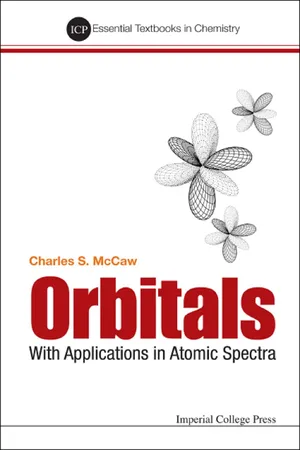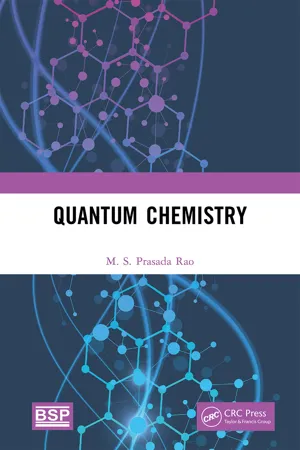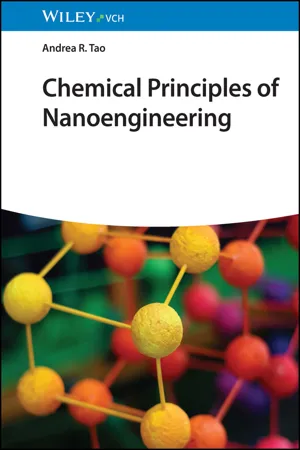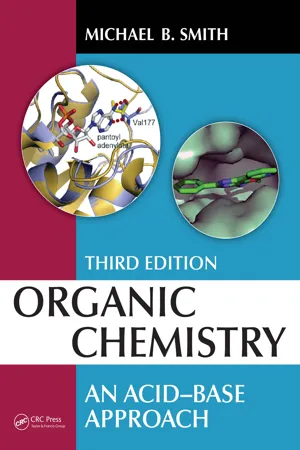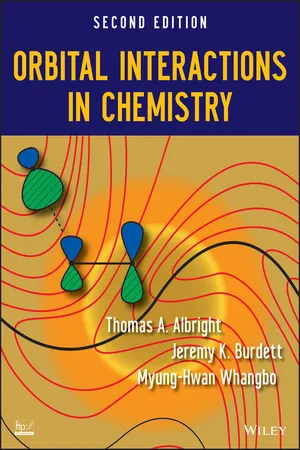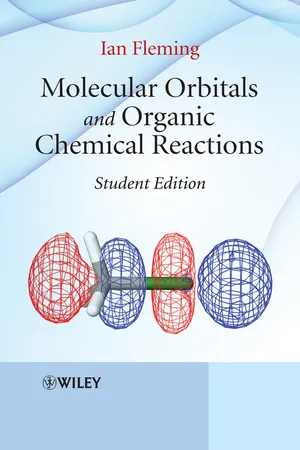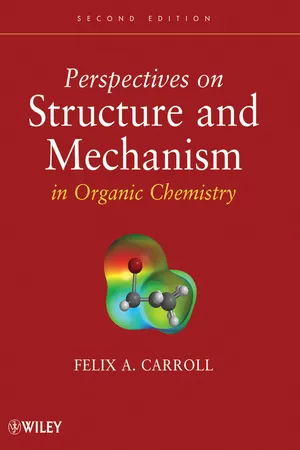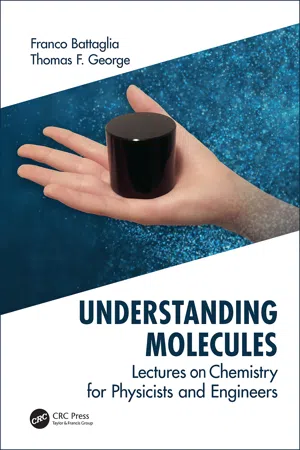Chemistry
Hybrid Orbitals
Hybrid orbitals are a concept in chemistry that result from the mixing of atomic orbitals to form new hybrid orbitals. These hybrid orbitals have different shapes and energies than the original atomic orbitals and are used to explain the molecular geometry and bonding in molecules. They are formed to accommodate the bonding requirements of the atoms in a molecule.
Written by Perlego with AI-assistance
Related key terms
Related key terms
1 of 4
Related key terms
1 of 3
9 Key excerpts on "Hybrid Orbitals"
- eBook - ePub
Orbitals
With Applications in Atomic Spectra
- Charles S McCaw(Author)
- 2015(Publication Date)
- ICP(Publisher)
These bond angles are not consistent with the 90° bond angles between p orbitals. The angles are justified by the concept of orbital hybridisation, popular with organic chemists in particular. s and p orbitals are considered to ‘mix’ to give these hybrids. It should be pointed out that such an approach, while a useful way of considering the electronic ground state of molecules, is an oversimplification. This is because hybridised orbitals (when relating to a platonic shape) are constructed to be energetically equivalent, yet photo-electron spectroscopy (PES) reveals different energy levels relating to the atomic orbitals that are distinguishable under the symmetry of the molecule. For example, the bonding electrons in methane have been shown to have two different energy levels (relating to the separate bonding interactions of the s and p orbitals on the carbon), despite the apparent similarity of the four sp 3 Hybrid Orbitals on carbon [ 80 ]. Figure 5.6. σ bonding and antibonding LCAOs of 2 p x orbitals: probability density contour maps in the xy -plane. Figure 5.7. π bonding and antibonding LCAOs of 2 p y orbitals: probability density contour maps in the xy -plane. Can the mixing of orbitals on an atom be justified on quantum mechanical grounds? We saw in Section 1.4 that we may be able to take linear combinations of the eigenfunctions with arbitrary constants in front of each eigenfunction, with the result still being an eigenfunction of the operator. It turns out that we can take useful linear combinations that are still eigenfunctions of the Hamiltonian operator. Following the comparison of the addition of eigenfunctions to the addition of vectors in Section 1.4, we can consider the p orbitals as vectors along their given axis. Given that the eigenfunctions are all normalised, we can assume that the p orbital vectors are all the same length - eBook - ePub
- M. S. Prasada Rao(Author)
- 2022(Publication Date)
- CRC Press(Publisher)
3 .Further, in case of BeH2 , BF3 and CH4 molecules the number of unpaired electrons present on the central atom is less than the number of covalent bonds formed. In order to explain this, it was presumed that the electrons are excited to the higher orbitals during the formation of covalent bonds. For example, beryllium has the excited state configuration 1s2 , 2s1 , 2px 1 . This should result in two nonequivalent bonds due to the overlap of the hydrogen atoms with 2s and 2px orbitals. However, in BeH2 both the bonds are equivalent and are at an angle of 180°. In order to explain such cases the concept of hybridization was introduced.According to the concept of hybridization, in cases where pure orbitals cannot affect good overlap in the formation of covalent bonds, combination of pure orbitals having same or similar energy takes place, resulting in the formation of equivalent Hybrid Orbitals. The number of Hybrid Orbitals formed is equal to the number of combining pure orbitals. If suppose ϕ1 and ϕ2 are the two combining atomic orbitals the resulting hybridized orbitals ψh 1 and ψh 2 areThe values of the coefficients should be such that each of the hybridized orbital is normalized and the two Hybrid Orbitals should be orthogonal to each other.ψ=h 1c 1ϕ 1+c 2ϕ 2ψ=h 2c 3ϕ 1+c 4ϕ 2. - eBook - ePub
- Andrea R. Tao(Author)
- 2023(Publication Date)
- Wiley-VCH(Publisher)
2 orbital:This allows us to form five equivalent Hybrid Orbitals by combining one 3s orbital, three 3p orbitals, and one 3d orbital. Thus, the appropriate hybridization is dsp3 .Note that Hybrid Orbitals do not always have to be equivalent. One can combine different percentages of orbitals to achieve bonding geometries that differ from those listed in Table 2.1 .2.3 Molecular Orbital Theory
In molecular orbital (MO) theory, bonds are formed by sharing electron density over multiple atomic nuclei. Electrons are delocalized over an entire molecule. Delocalization refers to electron motion that is not bound to a single atomic nucleus (Figure 2.12 ), in contrast to VB theory where electrons remain localized to specific atomic nuclei:Delocalized electron motion.Figure 2.12Instead of describing regions of overlap between atomic orbital wavefunctions, MO formalism describes bonding in terms of electron motion associated with molecular orbitals. MOs are formed by taking linear combinations of atomic orbitals, which is why they are sometimes referred to as LCAOs. A basis set or atomic orbital basis is defined as the set of wavefunctions that are used from the LCAOs.Let's again consider two generic atoms, atom A and atom B, that are separated by some internuclear distance. The bond formed between these atoms is described by the electrons that occupy MOs. Each MO can be occupied by a maximum of two electrons. To generate the wavefunction for a MO, we take linear combinations of the atomic orbitals on both atoms:(2.12)where cAand cBare coefficients that describe how much each atomic orbital contributes to the MO,ψ. A larger coefficient signifies that there is a higher probability of finding electrons near a given atomic nucleus. In the simple expression above, we have assumed that each atom only contributes one atomic orbital to bonding. Thus, the atomic basis is made up ofA−BϕandAϕB - eBook - ePub
Organic Chemistry
An Acid-Base Approach
- Michael B. Smith(Author)
- 2022(Publication Date)
- CRC Press(Publisher)
are formed: a linear combination of atomic orbitals. The molecular orbitals must be of a different energy relative to the atomic orbitals, and each molecule orbital will be of a different energy. One is of higher energy, and one is of lower energy. There can be no gain or loss of orbitals or electrons, so two electrons are found in the new molecular orbitals.Figure 3.5Molecular orbital diagram for diatomic hydrogen using the LCAO model.Each of the two hydrogen atoms has one electron as represented by a vertical arrow on the orbital energy line. Since there is no gain or loss of electrons when the molecular orbitals are formed, the two electrons reside in the lowest energy molecular orbital, and they will be spin paired. As shown in Figure 3.5 , this lower energy orbital is said to be a bonding molecular orbital . The higher energy orbital is an empty molecular orbital (no electrons), and it is usually referred to as an anti-bonding orbital . An anti-bonding orbital is an energy level that normally has no electrons in it. It is populated only when sufficient energy is provided to move an electron into that orbital or if an electron is added from an external source.3.5 Tetrahedral Carbons and sp3 Hybridization
Mixing the atomic s-orbitals of two hydrogen atoms to form molecular orbitals predicts the bonding in diatomic hydrogen (see Figure 3.5 ) with reasonable accuracy. There are limitations to the LCAO method, however, and if the atoms to be mixed have both s- and p-orbitals, there are problems. When the atomic orbitals of two carbon or two oxygen atoms are mixed using the LCAO method, the LCAO model does not - eBook - ePub
- Thomas A. Albright, Jeremy K. Burdett, Myung-Hwan Whangbo(Authors)
- 2013(Publication Date)
- Wiley-Interscience(Publisher)
For example, consider the orbital ϕ defined by p x and p y atomic orbitals as (6.1) The orbital addition is shown in 6.1 and 6.2 for the two cases c l = c 2 > 0 and c l = − c 2 > 0, respectively. The ratio c l / c 2 controls how much the orbital ϕ is tilted away from the x (or y) axis. The linear combination between z 2 and x 2 − y 2 orbitals of 6.3 leads to a z 2 − x 2 orbital, as readily appreciated from Table 1.1, since (6.2) Because r 2 = x 2 + y 2 + z 2, this is proportional to (6.3) The mixing of atomic orbitals with different angular momentum quantum number is also controlled by a vectorial addition and leads to various types of Hybrid Orbitals shown in Figure 6.1. The variation of the overlap or interaction integrals of these functions with other orbitals as a function of geometry are given simply by a weighted sum of the contributions from each component. So if (6.4) then (6.5) Figure 6.1 Hybridization of atom orbitals (a) s and p, (b) d xz and p z, (c) d z 2 and p z. 6.3 Molecular Orbitals of Diatomic Molecules Let us examine the valence molecular orbitals of a homonuclear diatomic, A 2 unit. The discussion here should be worked with care, for many of the elements presented will be found in other, more complex molecules. Each atom contributes four valence atomic orbitals (s, p x, p y, p z), and we identify the internuclear axis with the z direction. The basis orbitals naturally separate into those of σ (s, p z) and π (p x, p y) type. The π -type orbitals enter into a degenerate interaction and lead to π bonding and antibonding orbitals shown in Figure 6.2. Alternatively, the p x and p y orbitals on the two centers transform as π u + π g. Use of equation 4.37 leads to an in-phase combination of p x and p y on the two atoms for π u and hence a bonding pair of molecular orbitals and an out-of-phase combination for π g leading to an antibonding pair - eBook - ePub
- Björn O. Roos, Roland Lindh, Per �ke Malmqvist, Valera Veryazov, Per-Olof Widmark(Authors)
- 2016(Publication Date)
- Wiley(Publisher)
This is a very useful and powerful concept that we can use to describe chemical bonding and reactions. Figure 3.3 shows the two atomic 1s orbitals of H 2 close to equilibrium. Figure 3.2 Two hydrogen atoms at large separation. Figure 3.3 Two hydrogen atoms close to equilibrium. Using the two atomic 1s orbitals on the two hydrogen nuclei as a basis for describing, we can solve the Schrödinger equation within this subspace. For this purpose, let us express the wave function (orbital) as a linear combination of the two atomic orbitals,. Let us for simplicity assume that the orbitals () and coefficients() are real valued and further that the phase of the atomic orbitals is such that. The variation principle states that the expectation value for the energy of any wave function is higher than that for the exact ground state wave function. This can be expressed as 3.22 with equality only if. We can minimize with the constraint to obtain solutions within this subspace. Let us first evaluate and. 3.23 where and 3.24 where we have assumed that the atomic orbitals are normalized and.Minimizing the energy now gives the equation 3.25 The integrals are usually referred to as the Coulomb integral and as the resonance integral. To solve this equation for the energy, we can form the secular determinant 3.26 which has the solutions 3.27 where the plus sign corresponds to and the minus sign corresponds to. The former has lower energy and corresponds to a bonding orbital, while the latter corresponds to an antibonding orbital. Symmetry arguments would also have given us the solutions, and we can classify these orbitals by their symmetry. In a diatomic molecule, the angular momentum of the electron is not a preserved quantity, but the -component (assuming that the bond is along the -axis) of the angular momentum is. An orbital with no angular moment around the -axis is called a orbital - Ian Fleming(Author)
- 2011(Publication Date)
- Wiley(Publisher)
we who have chosen to picture them that way. It is better in such circumstances to refer to the atoms as being tetrahedral, trigonal, or digonal.1.3.5 C—C σ Bonds and π Bonds: EthaneWith a total of fourteen valence electrons to accommodate in molecular orbitals, ethane presents a more complicated picture, and we now meet a C—C bond. We will not go into the full picture-finding the symmetry elements and identifying which atomic orbitals mix to set up the molecular orbitals. It is easy enough to see the various combinations of the 1s orbitals on the hydrogen atoms and the 2s, 2px , 2py and 2pz orbitals on the two carbon atoms giving the set of seven bonding molecular orbitals in Fig. 1.19 .Fig. 1.19 The bonding orbitals and three antibonding orbitals of ethaneThere is of course a corresponding picture using sp3 hybrids, but the following account shows how easy it is to avoid them. We shall concentrate for the moment on those orbitals which give rise to the force holding the two carbon atoms together; between them they make up the C—C bond. The molecular orbitals (σ s and ), made up largely from 2s orbitals on carbon, are like the orbitals in hydrogen, in that the region of overlap is directly on a line between the carbon nuclei; as before, they are called σ orbitals. The bonding in the lower one is very strong, but it is somewhat offset by the antibonding (as far as the C—C bond is concerned) in the upper one. They are both strongly bonding with respect to the C—H bonds. There is actually a little of the 2px orbital mixed in with this orbital, just as we saw in Fig. 1.14 with a 2pz orbital, but most of the 2px orbital contributes to the molecular orbital σ x , which is also σ in character, and very strong as far as the C—C bond is concerned. This orbital has a little of the 2s orbital mixed in, resulting in the asymmetric extension of the lobes between the two carbon nuclei and a reduction in size of the outer lobes. This time, its antibonding counterpart (σ *x- No longer available |Learn more
- Felix A. Carroll(Author)
- 2011(Publication Date)
- Wiley(Publisher)
The Chemistry oftheAlkenes, Vol. I.; Wiley-Interscience: London, 1964; p. 106.8 Roberts, J. D. Molecular Orbital Calculations; W. A. Benjamin: New York, 1961.9 Nesbet, R. K. Variational Principles and Methods in Theoretical Physics and Chemistry; Cambridge University Press: Cambridge, UK, 2003.10 Eyring, H.; Walter, J.; Kimball, G. E. Quantum Chemistry; John Wiley & Sons: New York, 1944; p. 99.11 Applying the variational principle to obtain the best energy for a structure is often assumed to produce the best geometry and other observable properties as well, but that is not necessarily the case: Reed, L. H.; Murphy, A. R. J. Chem. Educ. 1986, 63, 757 and references therein.12 This argument covers only electron distribution or slight bond length or angle changes within the same structure, not isomerization to produce a different molecular structure.13 Pilar, F. L. Elementary Quantum Chemistry; McGraw-Hill: New York, 1968; p. 71.14 The value of this integral is unity if the wave functions are normalized.15 Mulliken, R. S. J. Am. Chem. Soc. 1950, 72, 4493.16 Brown, R. D. Q. Rev. Chem. Soc. 1952, 6, 63.17 Gutman, I. Top. Curr. Chem. 1992, 162, 29.18 For this and other ways of solving determinants, see (a) reference 2e, chapters 1–3; (b) reference 2d, pp. 442–458.19 As in the case of molecular hydrogen, combining two atomic orbitals produces two molecular orbitals—one bonding and one antibonding. To generalize, combining n atomic orbitals produces n molecular orbitals.20 Molecular orbitals having the same energy are said to be degenerate.21 A chemical structure in which one p orbital is perpendicular (and therefore orthogonal) to the p orbitals in the double bond, or one in which there is an insulating tetravalent carbon atom between the p orbital and the double bond, would have the same HMOs as does the reference system here.22 Although the one electron in ψ2 does not contribute to bonding in the radical, the two electrons in ψ1 produce bonding that causes the radical to be planar. Electron diffraction measurements on the radical indicated a planar structure with C–C bond length of 1.428 Å ± 0.013 Å and a C–C–C bond angle of 124.6 ±3.4°. Vajda, E.; Tremmel, J.; Rozsondai, B.; Hargittai, I.; Maltsev, A. K.; Kagramanov, N. D.; Nefedov, O. M. J. Am. Chem. Soc. 1986,108, 4352. For a theoretical study of allyl species, see Gobbi, A.; Frenking, G. J. Am. Chem. Soc. 1994,116, 9275 and references therein; Mo, Y. J. Org. Chem. 2004, 69, 5563; Linares, M.; Bra€ıda, B.; Humbel, S. J. Phys. Chem. A 2006,110, - eBook - ePub
Understanding Molecules
Lectures on Chemistry for Physicists and Engineers
- Franco Battaglia, Thomas F. George(Authors)
- 2018(Publication Date)
- CRC Press(Publisher)
The atomic orbitals 2 s (from the central atom) and σ g (from the hydrogen atoms), belonging to the same symmetry, combine to form two MOs, one bonding and one anti-bonding, and are labeled in the figure as σ 1 and σ 3 *. Likewise, for the orbitals 2 p z (from the central atom) and σ u (from the hydrogens), belonging to the same symmetry, they combine to form two MOs—one bonding and one anti-bonding—and are labeled in the figure as σ 2 and σ 4 *. Looking at things from a perturbation point of view (Section 4.4.1 and Figure 4.5), we may say that if the three 2 p atomic orbitals are degenerate when the central atom is isolated, the degeneracy is removed as the hydrogen atoms get closer, with an energy lowering of the 2 p z orbital, the only one which, in the linear geometry, can interact with the hydrogen atomic orbitals (specifically, with the σ u orbital). A possible combination between those 2 p isolated-atom atomic orbitals (whose symmetry is of the π type) and the two hydrogen atoms atomic orbitals (whose symmetry is of the σ type) does not alter the electronic density in the region between the nuclei, thereby generating non-bonding (and degenerate) MOs, also plotted in the figure. Let us now see what happens when the molecule is not linear. First of all, its symmetry properties would be altered and, following the spirit adopted so far, we should start by constructing basis atomic orbitals with the appropriate symmetry. The suitable mathematical tool to tackle the molecular symmetry properties is the so-called group theory, which is however foreign to the present elementary book. The concept of a group shall be introduced within the context of the structure of crystals in Section 8.4.2
Index pages curate the most relevant extracts from our library of academic textbooks. They’ve been created using an in-house natural language model (NLM), each adding context and meaning to key research topics.
Explore more topic indexes
Explore more topic indexes
1 of 6
Explore more topic indexes
1 of 4
